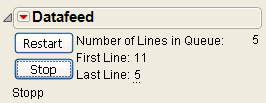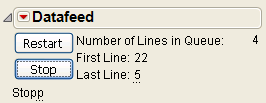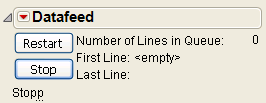Manage a Data Feed with Messages
A data feed object responds to several messages, including Connect and Set Script. These are detailed above as arguments for Open Datafeed(). They can also be sent as messages to a data feed object that already exists:
feed << Connect( port( "com1:" ), baud( 4800 ), databits( 7 ), parity( odd ), stopbits( 2 ) );
feed << Set Script( myScript );
The following messages could also be used as arguments to On Datafeed(). However, it would be more common to send them as messages to a data feed object that is already present.
You can send lines to a data feed from a script. This is a quick way to test a data feed. If you do not have a device available, Queue Line does not send data to a device; it simulates getting data from a device. Include a text argument or a global that stores text:
feed << Queue Line( "14" );
feed << Queue Line( myValue );
Here is a test script to queue five lines of data:
feed << Queue Line( "11" );
feed << Queue Line( "22" );
feed << Queue Line( "33" );
feed << Queue Line( "44" );
feed << Queue Line( "55" );
Figure 14.2 Datafeed: 5 Lines Queued
To get the first line currently waiting in the queue, use a Get Line (singular) message. When you get a line, it is removed from the queue. Five lines were queued with the test script above, and Get Line returns the first line and removes it from the queue:
feed << Get Line
"11"
Figure 14.3 Datafeed: 4 Lines Queued
To empty all lines from the queue into a list, use Get Lines (plural). This returns the next four lines from the test script in list { } format.
myList = feed << GetLines;
{ "22", "33", "44", "55" }
Figure 14.4 Datafeed: 0 Lines Queued
To stop and later restart the processing of queued lines, either click the Stop and Restart buttons in the Datafeed window, or send the equivalent messages:
feed << Stop;
feed << Restart;
To close the data feed and its window:
feed << Close;
To disconnect from the live data source:
feed << Disconnect
Message | Syntax | Explanation |
|---|---|---|
Open Datafeed Datafeed | feed = Open Datafeed( commands ) | Creates a data feed object. Any of the following can be used as commands inside Open Datafeed or sent as messages to an existing data feed object. Datafeed is a synonym. |
Set Script | feed << Set Script( script ) | Assigns the script that is run each time a line of data is received. |
Get Line | feed << Get Line | Returns and removes one line from the data feed queue. |
Get Lines | feed << Get Lines | Returns as a list and removes all lines from the data feed queue. |
Queue Line | feed << Queue Line( string ) | Sends one line to the end of the data feed queue. |
Stop | feed << Stop | Stops processing queued lines. |
Restart | feed << Restart | Restarts processing queued lines. |
Close | feed << Close | Closes the data feed object and its window. |
Connect | feed << Connect( Port( "com1:" | "lpt1:" | ... ), Baud( 9600 | 4800 | ... ), Data Bits( 8 | 7 ), Parity( None | Odd | Even ), Stop Bits( 1 | 0 | 2 ), DTR_DSR( 0 | 1 ), RTS_CTS( 0 | 1 ), XON_XOFF( 1 | 0 ) ) | (Windows only) Sets up port settings for the connection to the device. The symbol | between arguments represents “or”; choose one argument for each setting. |
Disconnect | feed << Disconnect | (Windows only) Disconnects the device from the data feed queue but leaves the data feed object active. |


